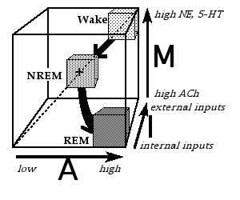Dreaming as Delirium is a book written by J. Allan Hobson, a professor of psychiatry and researcher at Harvard Medical School. His specialty is sleep research and states of consciousness. I mention that phrase a lot here, “state of consciousness.” So do people into meditation and spiritual cultivation.
The Upanishads and Western science speak of three major states of consciousness: waking, deep sleep (non-REM sleep), and dreaming (REM sleep). Hobson’s contribution to this discussion is something called the AIM Model. The Activation energy, Information, and Mode model (AIM) creates a three dimensional cube of “mind space.”
This cube is defined along three axes:
1) Activation or Arousal of the brain (is it low or high as measured by the power of an EEG signal).
2) Input or Information (the degree to which information arises from external sources via the senses, or is created internally by endogenous brain activity- as when we dream).
3) Modulation or Mode of data organization (mediated by neurotransmitters with either cholinergic (ACh in the diagram) or aminergic & serotonergic dominance( NE & 5-HT)). Is one’s thinking logical and linear or more fantasy based and emotional? Neurotransmitters determine this. As logic decreases so does working memory. As emotion increases so does remote memory.
Within this cube one may plot different states of consciousness as determined by different physiological variables. Normally, one traverses a rather narrow path from one region of this cube to anotheras one passes from waking to sleeping to dreaming. Waking state plots up it the back right corner. Dreaming (REM) maps to the lower front right corner. Deep sleep (non-rapid eye movement sleep, NREM) occurs somewhere in the center. But one can also map lesser traveled routes. Coma finds one in the lower front left corner. Lucid dreaming lies towards the back near the lower right side.
What this model emphasizes is how very much "room" exists physiologically that could support different states of consciousness. The other thing to note is that states of consciousness are actually created and maintained by a wide variety of physiological variables. The AIM Model simply maps the primary variables. It is possible that at any given spot within the AIM cube one could insert yet another cube whose axies are defined by yet three additional variables.
In the past, it was thought that the three states of consciousness were mutually exclusive. Now we know that state-determining variables can be mixed. For instance, walking in your sleep is REM sleep physiology minus the variable of muscle paralysis. Hypnagogic hallucinations occur during a "minor" state of consciousness in which some brain variables create dreams, while the rest of the physiology is closer to waking state.
AIM also highlights the manner in which states of consciousness can be changed by manipulating any one of the three primary variables. For example, meditation or hypnosis change the level of excitation. Coffee (with the amine caffeine) or psychedelics (many of which are serotonin analogs), alter the chemical balance of neurotransmitters.
This AIM model is science reiterating what Maharishi used to tell us. Every state of consciousness is supported by a unique physiology. Cultivating consciousness is like moving a table. You can grab hold of any leg (any one of a number of physiological variables) and pull. The whole table will move.
So, grab hold of the leg that is easiest to reach. Meditation effects EEG, galvanic skin response, serotonin. It turns the attention inwards… these are all primary AIM variables. By contrast, Maharishi downplayed affirmations as mere "mood making, " or trying to cultivate a state of non-attachment by thinking alone. These methods don’t really affect the physiology all that much. In short, trying to philosophize ones way to enlightenment (Gyana Yoga) was well nigh impossible for most of us.
Which brings me back to Adyashanti and too much Thinking!
Enlightenment starts in the body with direct experience, not the thinking mind.


No comments:
Post a Comment